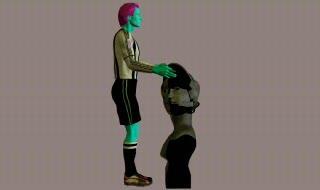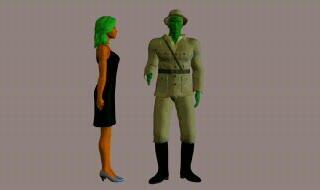
Translation: "Referee statue pick up." Above is one of the 80 animated video clips used to teach an artificial language to study participants. Cognitive scientists are just beginning to use artificial languages to explore how the brain learns and processes language.
(Photo Credit: University of Rochester)

Translation: "Singer hunter chop." Unlike English, the artificial languages used in the study have free word order. When the subject and object could be easily confused, participants chose to reshape the language by using case marker to make their meaning clear. This created the same pattern seen in naturally occurring languages such as Japanese and Korean and may help to explain why so many of the worlds languages share similar structures.
(Photo Credit: University of Rochester)
Source: University of Rochester